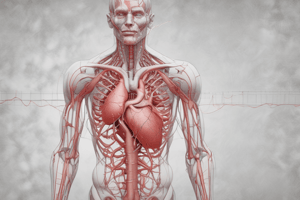Podcast
Questions and Answers
What is the primary function of the cardiovascular system?
What is the primary function of the cardiovascular system?
- Maintain skeletal muscle tone
- Regulate body temperature
- Deliver oxygenated blood and remove waste products (correct)
- Regulate hormone production
What part of the nervous system controls the heart's pumping action?
What part of the nervous system controls the heart's pumping action?
- Central nervous system
- Autonomic nervous system (correct)
- Peripheral nervous system
- Somatic nervous system
Where are the heart and major blood vessels located in the body?
Where are the heart and major blood vessels located in the body?
- Pelvic region
- Upper back region
- Abdominal cavity
- Chest cavity, behind the sternum (correct)
What is the approximate weight of the heart in an adult male?
What is the approximate weight of the heart in an adult male?
Which chamber of the heart receives oxygenated blood from the lungs?
Which chamber of the heart receives oxygenated blood from the lungs?
What is the function of the atrioventricular valves?
What is the function of the atrioventricular valves?
Which valve is located between the right ventricle and the pulmonary artery?
Which valve is located between the right ventricle and the pulmonary artery?
What is the largest and most muscular chamber of the heart?
What is the largest and most muscular chamber of the heart?
What is the primary function of the Aortic Semilunar Valve?
What is the primary function of the Aortic Semilunar Valve?
What is the source of the 'lub' sound (S1) in the heart?
What is the source of the 'lub' sound (S1) in the heart?
During which phase of the cardiac cycle is S2 heard?
During which phase of the cardiac cycle is S2 heard?
What is the origin of the 'dubb' sound (S2)?
What is the origin of the 'dubb' sound (S2)?
What is the cause of S3 and S4 heart sounds?
What is the cause of S3 and S4 heart sounds?
What is a murmur?
What is a murmur?
Where is the Aortic Area located for auscultating heart sounds?
Where is the Aortic Area located for auscultating heart sounds?
What is the term for the rapid ventricular filling that causes S3 heart sound?
What is the term for the rapid ventricular filling that causes S3 heart sound?
Flashcards are hidden until you start studying
Study Notes
The Cardiovascular System
- The cardiovascular system plays a crucial role in the body, delivering oxygenated blood and removing waste products.
- The autonomic nervous system controls the heart's pumping action.
- The vascular network, comprising arteries, veins, and capillaries, carries blood throughout the body, maintaining blood pressure and keeping the heart filled with blood.
The Heart
- The heart is a cone-shaped muscle located centrally in the chest, behind the protective sternum.
- It has four chambers and is a double pump, approximately 12 cm long and 9 cm wide, weighing 250-390 g in adult males and 200-275 g in adult females.
Heart Chambers, Valves, and Circulatory Flow
- The heart has four chambers: the right atrium, right ventricle, left atrium, and left ventricle.
- The right atrium receives deoxygenated blood from the body, the right ventricle pumps it to the lungs, the left atrium receives oxygenated blood from the lungs, and the left ventricle pumps blood into the systemic circulation.
- The heart has four valves: the tricuspid valve, bicuspid (mitral) valve, pulmonic semilunar valve, and aortic semilunar valve.
- The atrioventricular valves (tricuspid and bicuspid) prevent backflow from the ventricles to the atria, while the semilunar valves (pulmonic and aortic) prevent backflow from the arteries to the ventricles.
Heart Sounds
- Heart sounds are produced by valve closure, with valve opening being silent.
- The normal heart sounds are S1 (lub) and S2 (dubb).
- S1 is the result of closure of the atrioventricular valves, correlating with the beginning of systole, and is best heard at the apex of the heart.
- S2 is the result of closure of the semilunar valves, correlating with the beginning of diastole, and is best heard at the base of the heart.
- Extra heart sounds include S3 and S4, which are diastolic filling sounds resulting from ventricular vibration, and murmurs, which are audible and prolonged sounds resulting from turbulent blood flow.
Auscultating Heart Sounds
- The traditional 5 areas for auscultating heart sounds are:
- Aortic area: 2nd ICS at the right sternal border (base of the heart)
- Pulmonic area: 2nd or 3rd ICS at the left sternal border
- Erb's point: 3rd ICS at the left sternal border
- Tricuspid area: 4th ICS at the left sternal border
- Mitral area: 5th ICS at the left midclavicular line (apex of the heart)
Studying That Suits You
Use AI to generate personalized quizzes and flashcards to suit your learning preferences.




